Unlock the Astonishing Potential of AI Image Upscaler and Enhancements with Topaz Labs’ Game-Changing Software
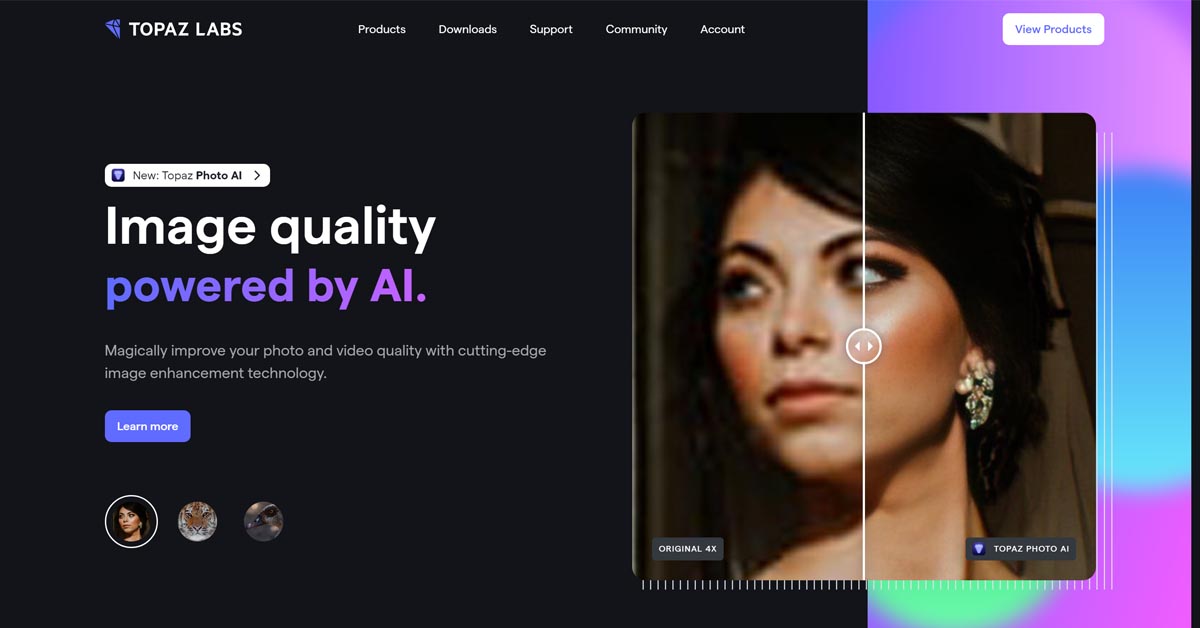
Welcome to our latest blog post, where we delve into the fascinating world of AI Image Upscaler technology. We’ll explore its transformative effects on photography and how it’s reshaping the industry. Dive in and discover the incredible potential of AI-driven image enhancement!
Table of Contents
I. Introduction
Briefly introduce Topaz Labs as a company
Topaz Labs is a well-known software company specializing in advanced image editing and enhancement tools for photographers and digital artists. Founded in 2005 and based in Texas, USA, they have consistently pushed the limits of photo enhancement with their visionary solutions. Topaz Labs is widely recognized for its devotion to merging artificial intelligence (AI) technologies into its products, creating advanced image processing that is more convenient and efficient for users.
Overview of their AI-based photography software
Topaz Labs offers a suite of AI-powered photography software designed to improve various aspects of digital images, such as resolution, sharpness, and noise reduction. Their lineup includes Topaz Photo AI, Gigapixel AI, Sharpen AI, and Video AI, each catering to specific needs in the digital imaging workflow. These tools leverage cutting-edge AI algorithms to deliver remarkable results, often surpassing traditional methods in terms of quality and ease of use. I excluded Video AI from this article as I need to test it thoroughly more, and I can only review or recommend software or service I know more about.
The Importance of artificial intelligence in modern photography
AI has emerged as a game-changing force in photography, offering new possibilities for image enhancement and streamlining complex processes that were previously time-consuming or inaccessible to many users. AI-driven tools can analyze and process image data more effectively, delivering superior results while requiring less manual intervention. For professional photographers, AI-based software can significantly enhance the quality of their work and help them achieve their creative vision with enhanced precision and efficiency. AI technologies’ continued growth and evolution promise to revolutionize how we capture, edit, and experience visual content in the coming years.
II. Topaz Photo AI
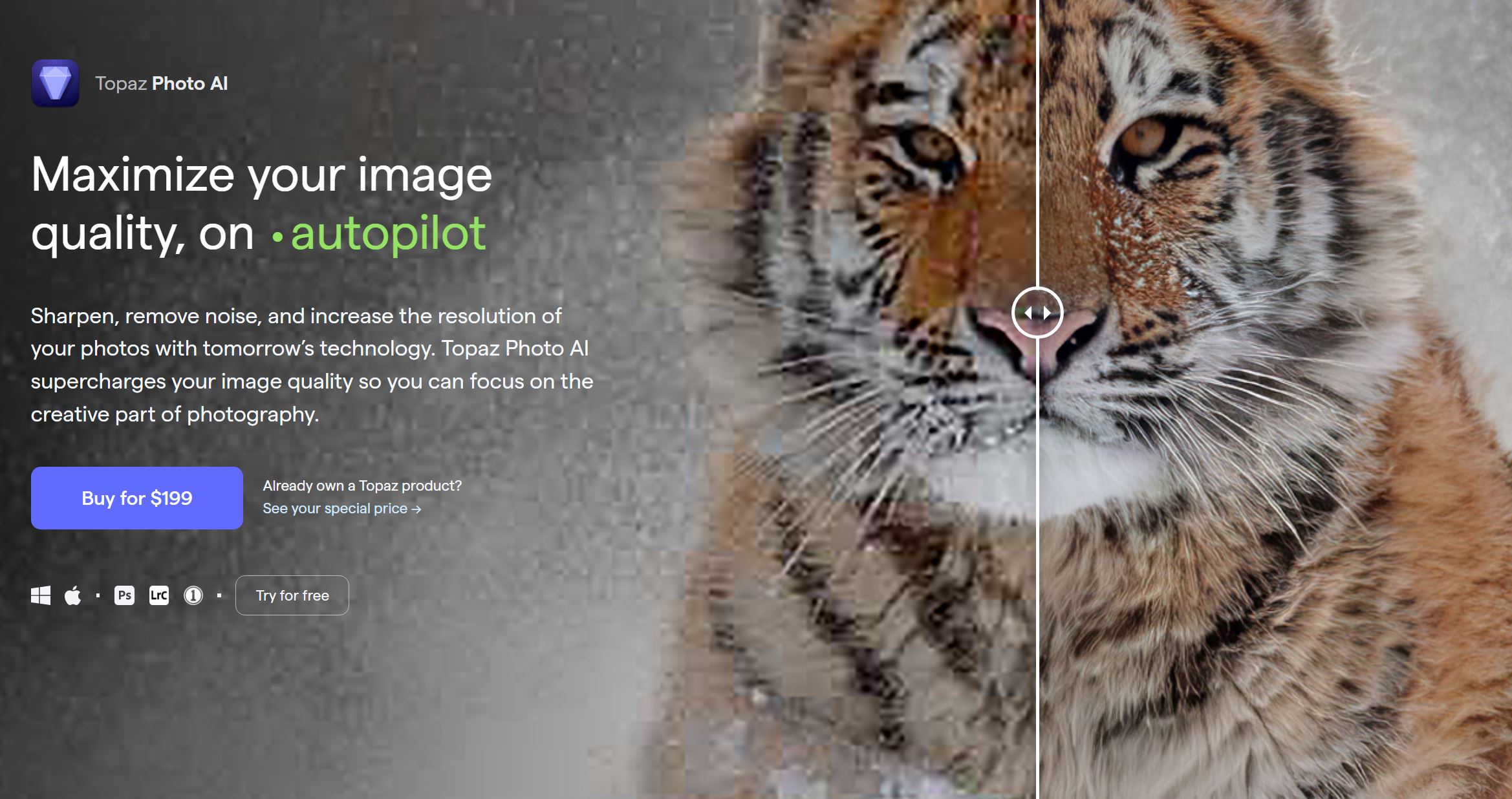
Topaz Photo AI is comprehensive photo editing and enhancement software that harnesses artificial intelligence to optimize and refine digital images. Designed for amateur and professional photographers, this versatile software offers an extensive range of AI-driven features to improve image quality, correct common issues, and bring out the true beauty in your photos. It’s intuitive interface, and powerful tools make it an invaluable addition to any photographer’s toolkit, enabling you to achieve stunning results quickly.
Features and Capabilities
Topaz Photo AI software offers impressive features designed to enhance and perfect your images. The following are key capabilities:
Adjustments powered by AI:
With machine learning algorithms, Topaz Photo AI can automatically analyze and apply intelligent adjustments to various aspects of your photos, such as removing noise and sharpening and enhancing resolution (enlarging the image).
Advanced masking:
Topaz Photo AI offers a sophisticated automated subject masking tool and the ability to adjust specific areas of an image. Masking is automated, but you can refine the area like Photoshop’s magic wand tool, so it is not pixel-precise control.
Seamless integration with popular photo editing software:
Topaz Photo AI is compatible with industry-standard software like Adobe Photoshop (including Elements) and Lightroom, allowing you to incorporate powerful features into your existing workflow easily.
Batch processing capabilities:
Save time by simultaneously applying your favorite adjustments to multiple images, ensuring a consistent look and feel across your entire photo collection. This is a life-saver feature. I have batch-processed over 600 images simultaneously, and that workhorse rides with no problem. It is possible to use the same settings for all photos in a batch or to set individual settings for each shot.
Use cases and real-world examples
Topaz Photo AI is suitable for various photography genres and applications, such as:
Landscape photography: Topaz Photo AI’s features enhance details and reduce noise in challenging lighting conditions to create stunning, vibrant landscape images. With powerful Upscaling features, you get fantastic wall prints with exquisite details.
Portrait, Event, and low-light photography: With its powerful noise reduction capabilities, Topaz Photo AI is ideal for situations where shooting at high ISO settings is necessary, such as weddings, concerts, or indoor events.
Photographing wildlife and sports: With Topaz Photo AI’s AI-powered sharpening and noise reduction tools, you’ll be able to bring out details in fast-moving subjects and get crisp, clear shots despite difficult lighting conditions.
Upscale HDR images: While HDR images don’t differ from other image formats in the case of upscaling, Topaz Photo AI is a powerful tool for getting those stunning HDR images upscaled with excellent quality.
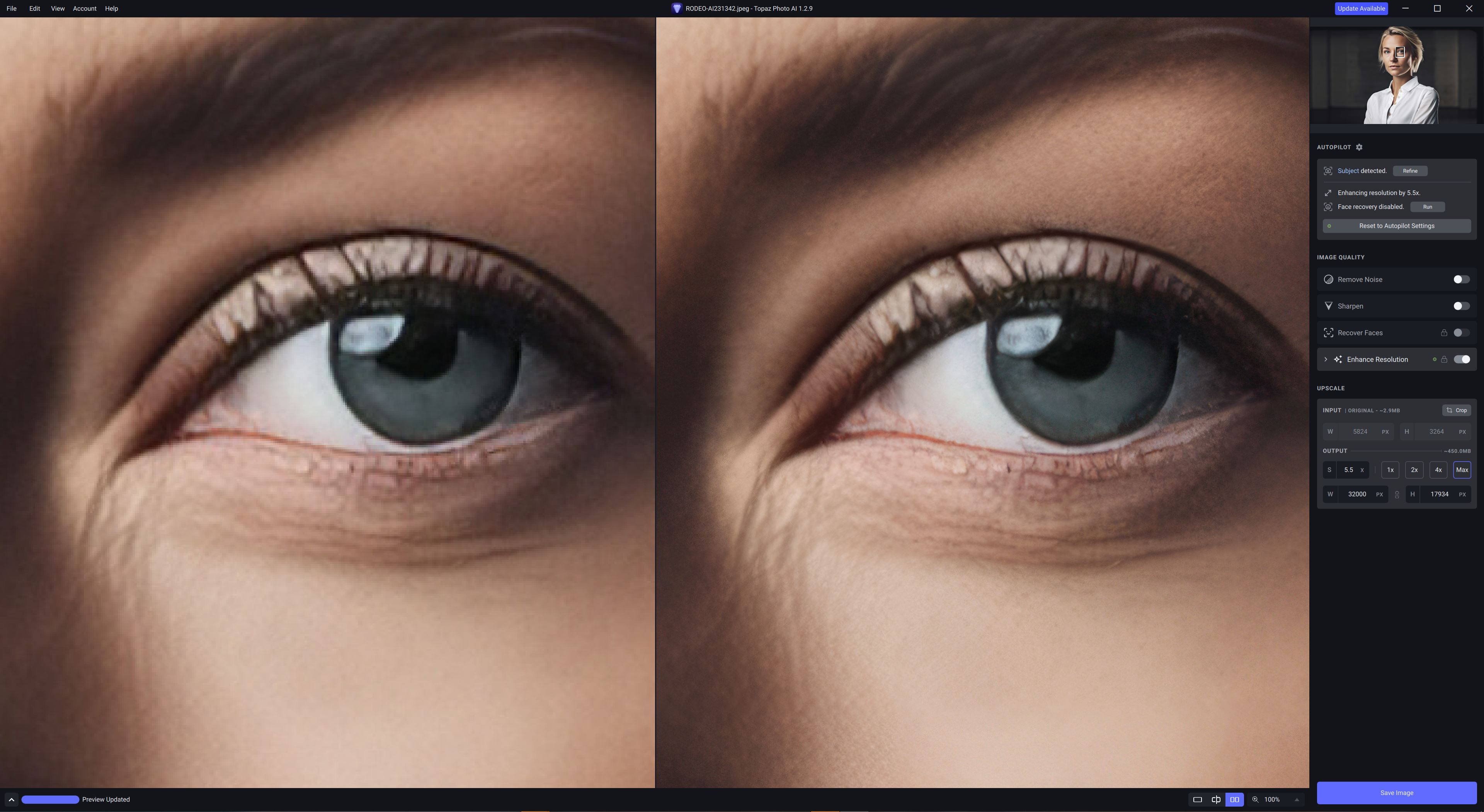
Comparisons to other popular photo editing software
This is how it compares to other popular software:
Adobe Photoshop and Lightroom: Both Adobe products offer a complete suite of photo editing tools but rely primarily on traditional image processing techniques. Photoshop today comes with a new set of AI-powered tools called neural filters. They offer various enhancement tools, from restoring colors to old black-and-white pictures to change how people look, their heads angle, adding a smile, where their eyes look, and so forth. It is really going to be a wild ride with AI solutions.
Luminar Neo: It also focuses on AI-powered photo enhancement. However, Luminar Neo’s feature set is more geared toward creative effects and compositing, like replacing the sky, while Topaz Photo AI is designed for image quality enhancement. However, you can purchase extensions to Luminar AI, which extend its functionality over Topaz Photo AI, like SuperSharp AI, Noiseless AI, Upscale AI, Focus Stacking, Magic Light AI, and so forth. Still, it adds a price tag of 49 USD for each feature or everything in one Pro bundle of 119 €/year or the one-lifetime deal of 328 € with all extensions.
DxO PhotoLab: DxO PhotoLab is known for its advanced lens correction and noise reduction capabilities. It is a powerful photo editing tool and has now added AI capabilities, at least for noise reduction. It is called DeepPRIME, and they say, “Denoising and image enhancement like nothing else.” I checked it and think it is impressive.
Topaz Photo AI offers a comprehensive set of AI-based tools that significantly enhance image quality and streamline editing. Its focus on problem-solving and intelligent adjustments makes it a valuable addition to any photographer’s software lineup.
III. Gigapixel AI – Excellent AI Image Upscaler
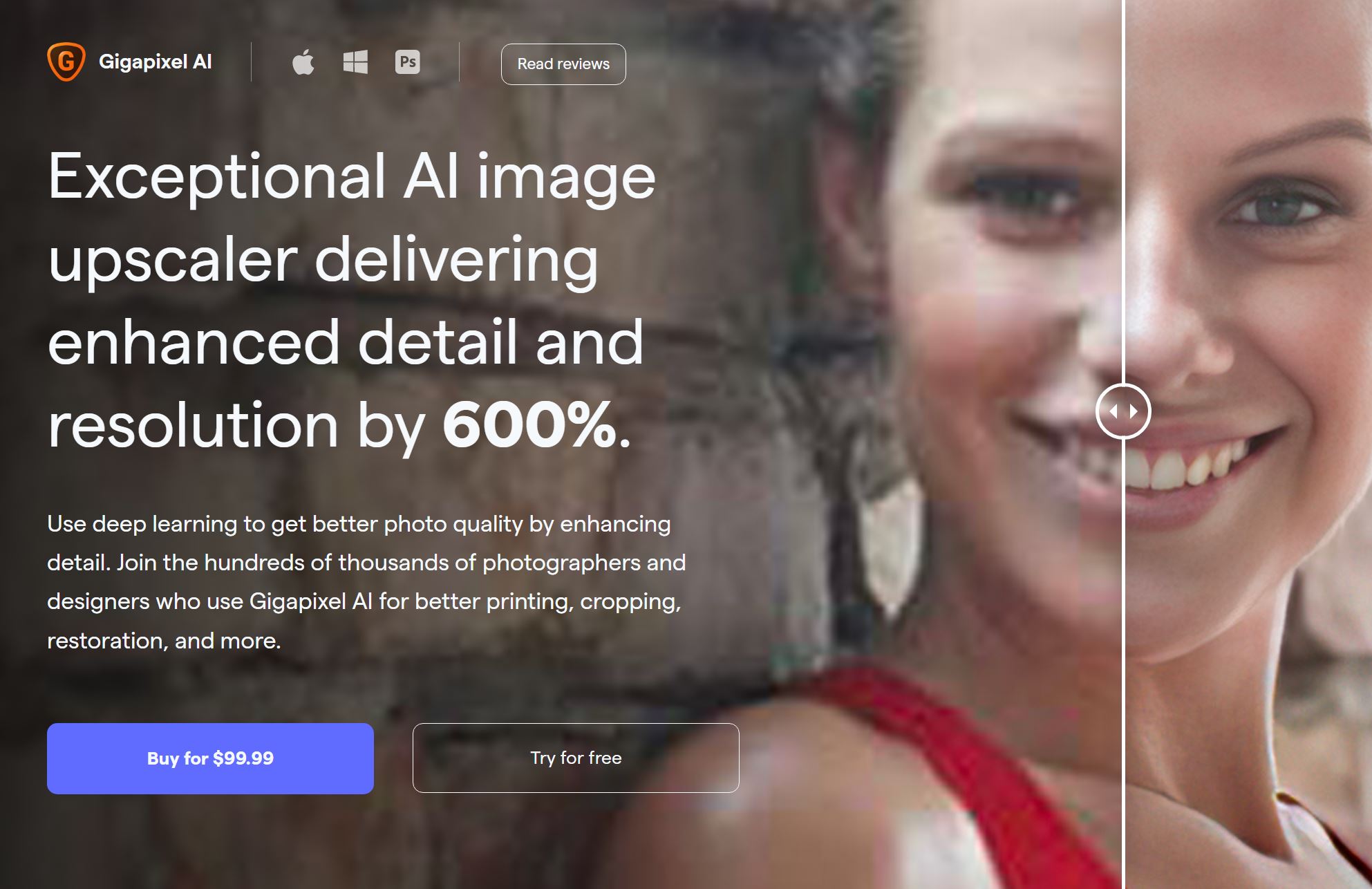
Purpose and my personal experience
Gigapixel AI is powerful AI image upscaler software developed by Topaz Labs. It is specifically designed to increase digital image resolution while maintaining and often improving overall image quality. Utilizing advanced AI algorithms, Gigapixel AI can enlarge images by up to 600%, and this is without the pixelation, loss of detail, or artifacts typically associated with traditional upscaling methods. This software is invaluable for photographers, designers, and digital artists who require high-resolution images for large prints or complex projects.
I have used this several times for my clients when they need an upscaled SLR image. I remember my first Gigapixel use. My client had chosen a nighttime photo taken with my old Canon 5D Mark III (22,3mpix). It was good quality in regular size, but first, using Photoshop’s traditional scaling, the results were unacceptable because the client wanted to print a high-quality photo wallpaper for an office space 3 meters high. As a result of upscaling it with Gigapixel, I almost fell from the chair trying to find some significant mistakes in the enhanced image but was unable to find them. As you can guess, that client was thrilled, and I discovered my secret tool to upscale happiness.
Features and Capabilities
Gigapixel AI boasts a range of innovative features, including:
AI-driven image upscaling: Gigapixel AI’s primary strength lies in its AI-driven image upscaling capabilities. The software uses advanced machine learning algorithms to analyze the input image and intelligently increase its resolution. Unlike traditional upscaling methods that result in pixelation or blurry photos, Gigapixel AI maintains original quality and detail. This is done by synthesizing the pixels based on the surrounding information. This enables the software to create crisp, high-resolution images that closely resemble the original, even when significantly enlarged. I’m amazed it does it exceptionally well, considering there isn’t that detail anywhere.
Advanced detail preservation: One of the key advantages of Gigapixel AI is its ability to preserve intricate details and maintain image sharpness during upscaling. The software uses AI algorithms to identify and enhance critical textures and features within the image. This ensures sharpness and clarity even at higher resolutions. This results in images that maintain their original quality and detail, as well as when upscaled by a significant factor. Automation makes even too sharp images by default, so I usually move the slider and adjust it to “not that sharp.” Everyone does what they see fit, of course, because it is a matter of personal taste.
Artifact reduction: Upscaling images can introduce unwanted artifacts, such as jagged edges, halos, and moiré patterns. Gigapixel AI is specifically designed to minimize these artifacts during upscaling. The software’s AI algorithms identify potential problem areas and apply targeted adjustments to reduce or eliminate artifacts. This leads to cleaner, more natural-looking images that maintain their original quality and aesthetic appeal, even when significantly enlarged. Again I have to repeat myself, and I have been happy that it works so well.
Batch processing capabilities: Save time by upscaling multiple images simultaneously, streamlining your workflow, and ensuring consistent results across a series of images.
User-friendly interface: Gigapixel AI features an intuitive and easy-to-navigate interface, allowing users of all skill levels to quickly and efficiently upscale their images.
Use cases and real-world examples
Gigapixel AI is well-suited to various applications and benefits different industries and photography genres, including:
- Large format printing: Gigapixel AI’s advanced upscaling capabilities benefit photographers and designers who require high-resolution images for large format printing, such as billboards, banners, or fine art prints. The software enlarges images while preserving quality and detail, ensuring crisp and clear prints of any size.
- Stock photography: Stock photographers can use Gigapixel AI to upscale their images and offer clients a more comprehensive range of size options, potentially increasing their sales and marketability. As mentioned, I have upscaled pictures for my clients when regular stock-size photos aren’t enough.
- Restoration and archival projects: Gigapixel AI can be invaluable for restoring and digitizing old or low-resolution photographs, film negatives, or slides. Users can breathe new life into cherished memories or historical artifacts by upscaling and enhancing image quality.
- Digital art and graphic design: Digital artists and graphic designers can benefit from Gigapixel AI’s ability to upscale images and maintain quality for large-scale projects or high-resolution displays.
How to upscale an image?
- Import your image: Launch Gigapixel AI and click on the “Open” button to import the image you want to upscale. Alternatively, you can drag and drop the image into the software interface.
- Select the output size: In the “Resize Mode” section, manually enter the new dimensions or select presets of 0.5X, 2X, 4X, 6X, or Custom up to 20X. You can upscale images up to 6x their original size with AI Image Upscaler. Bigger than that, you’re triggering a warning that 600% Upscaling is possible while preserving quality, and above that image is scaled using traditional scaling methods after it is scaled to 600% with AI.
- Choose the AI model: Gigapixel AI offers various AI models to cater to different image types and desired results. Select the appropriate AI model from the side menu, such as Standard, Lines, Art & CG, HQ, Low Res, and very compressed.
- Adjust the settings: Fine-tune the upscaling process using sliders for “Suppress Noise” and “Remove Blur” to optimize the image’s quality. When upscaling portraits, you can also enable the “Face Recovery” option for enhanced facial details.
- Preview the results: Multiple different viewing modes are useful for serious upscaling. You can use the Comparison view at the start, where you see the preview results with all upscaling modes simultaneously with the Zoom level you choose. I love it! After choosing the AI model, you can switch to Side by Side View to see the Before and After types of view.
- Save the upscaled image: Once you’re satisfied with the results, click on the “Save Image” or “Images” button to choose the destination folder, file format, and quality settings for your upscaled image. Click “Save” again to export the final, upscaled image(s). Voilá, you’re a professional AI Image Upscaler!
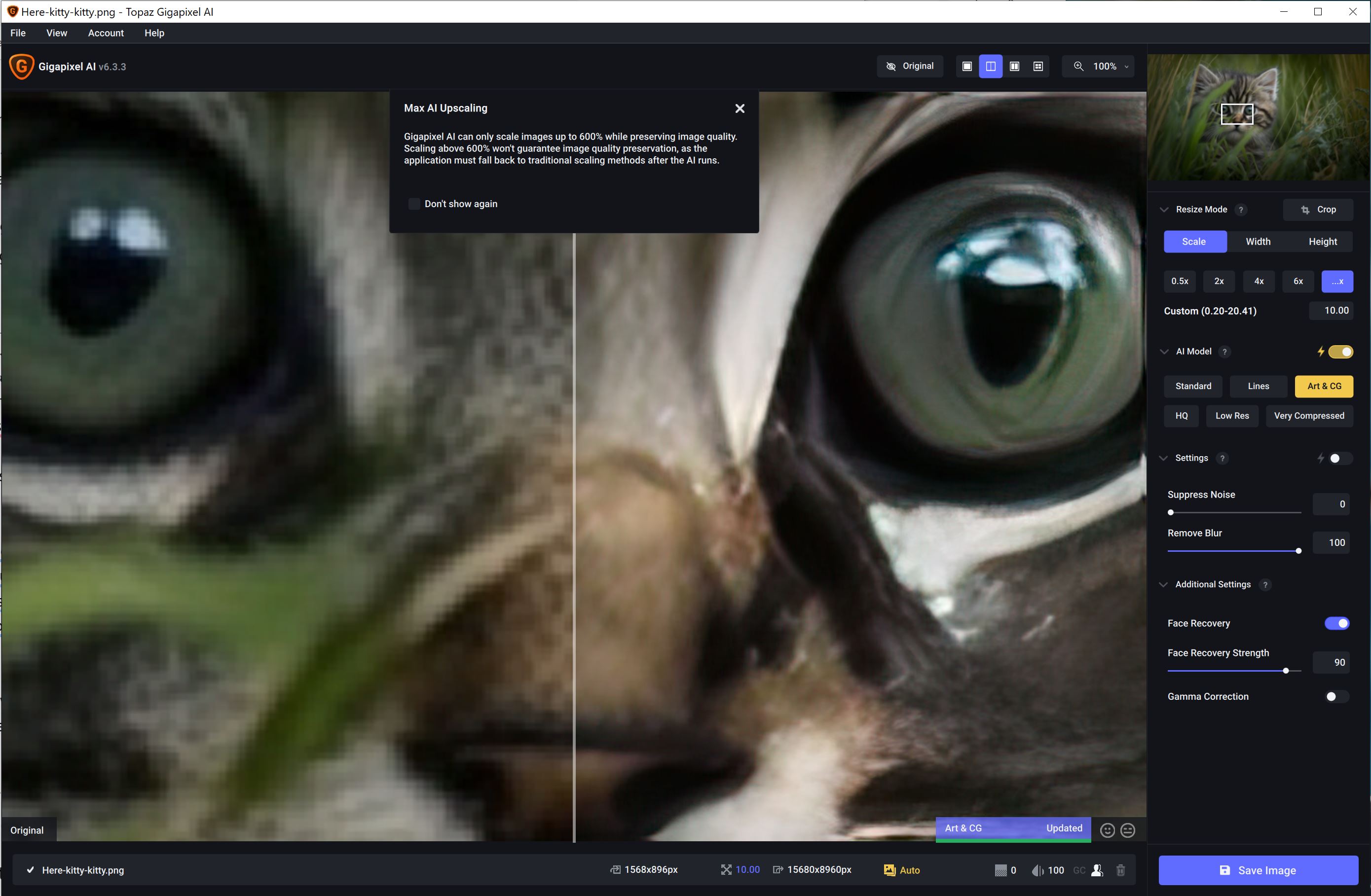
By following these steps, you can easily upscale your images using Gigapixel AI, achieving remarkable high-resolution results while maintaining sharpness, detail, and overall image quality.
HINT: If you lack image material to test and play around with, you can download free images from Pixbuster and start playing with the free trial versions of the software.
Comparisons to other image upscaling solutions
Gigapixel AI stands out from other image upscaling solutions due to its AI-driven approach and superior results. Here’s how it compares to other popular options:
- Adobe Photoshop: Photoshop offers several upscaling methods, such as Bicubic, Preserve Details, and Nearest Neighbor. While these methods can produce acceptable results in some small-scale situations, they can’t get even near the quality compared to Gigapixel AI’s advanced AI-driven upscaling, which delivers superior detail preservation and artifact reduction.
- ON1 Resize AI: ON1 Resize AI is a popular AI image upscale solution that uses neural networks to enlarge images. I have yet to test this new AI-based upscaling software, even though older ON1 solutions have been familiar for a long time.
- Traditional upscaling algorithms (e.g., Lanczos, Bicubic): These conventional methods can lead to loss of detail, pixelation, or artifacts when enlarging images. Gigapixel AI’s AI-driven approach offers a more advanced and effective solution for maintaining image quality during upscaling. The old ways of doing things have their place when doing things on a small scale. However, why not use AI-based software for anything upscaling above 100%?
Gigapixel AI sets itself apart with its innovative AI image upscaling capabilities, making it a top choice for photographers, designers, and digital artists who require high-quality, large-scale images. What I like is that they continually update and improve the software, and they push it forward, and I like it because with AI solutions exploding everywhere, you have to continue being in the top 3.
IV. Sharpen AI
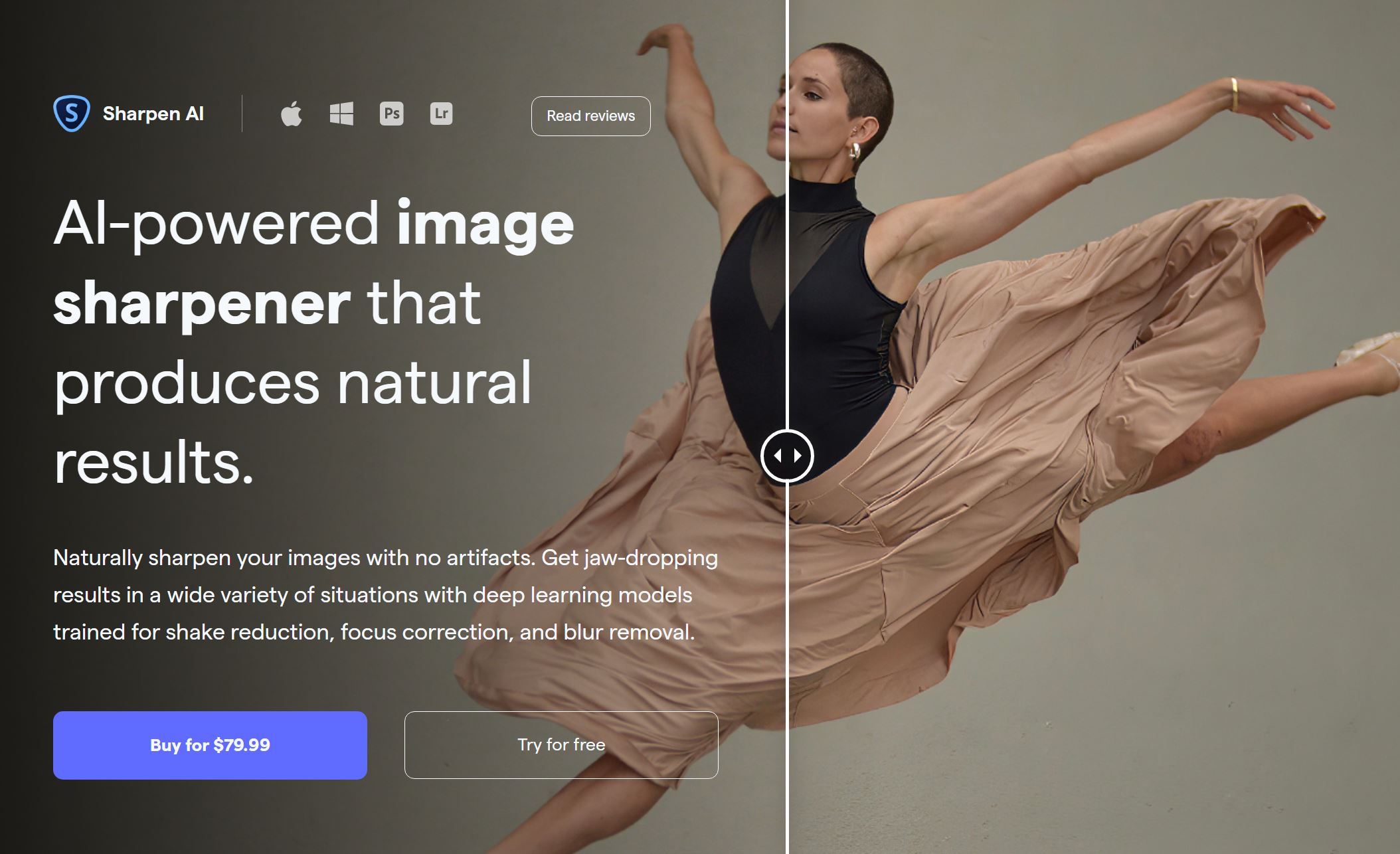
Sharpen AI is specialized image-sharpening software developed by Topaz Labs. It addresses common image sharpness issues, such as motion blur, out-of-focus blur, and general softness. By leveraging artificial intelligence, Sharpen AI can analyze and correct these issues with impressive accuracy. This results in crisp and clear images that maintain their original quality. This software is an invaluable tool for photographers who need to rescue slightly blurry shots or want to enhance the sharpness of their images. This is for a more professional and polished look.
Sharpen AI boasts several innovative features that set it apart from other image-sharpening solutions, including:
AI-powered sharpening: Sharpen AI uses machine learning algorithms to intelligently analyze and correct image sharpness issues, delivering precise and targeted adjustments without introducing artifacts or over-sharpening.
Three distinct sharpening modes: The software offers four specialized modes to address different sharpness issues: Standard, Motion Blur, Out-of-Focus Blur, and Too Soft. These modes enable users to apply the appropriate level and sharpening for their situation.
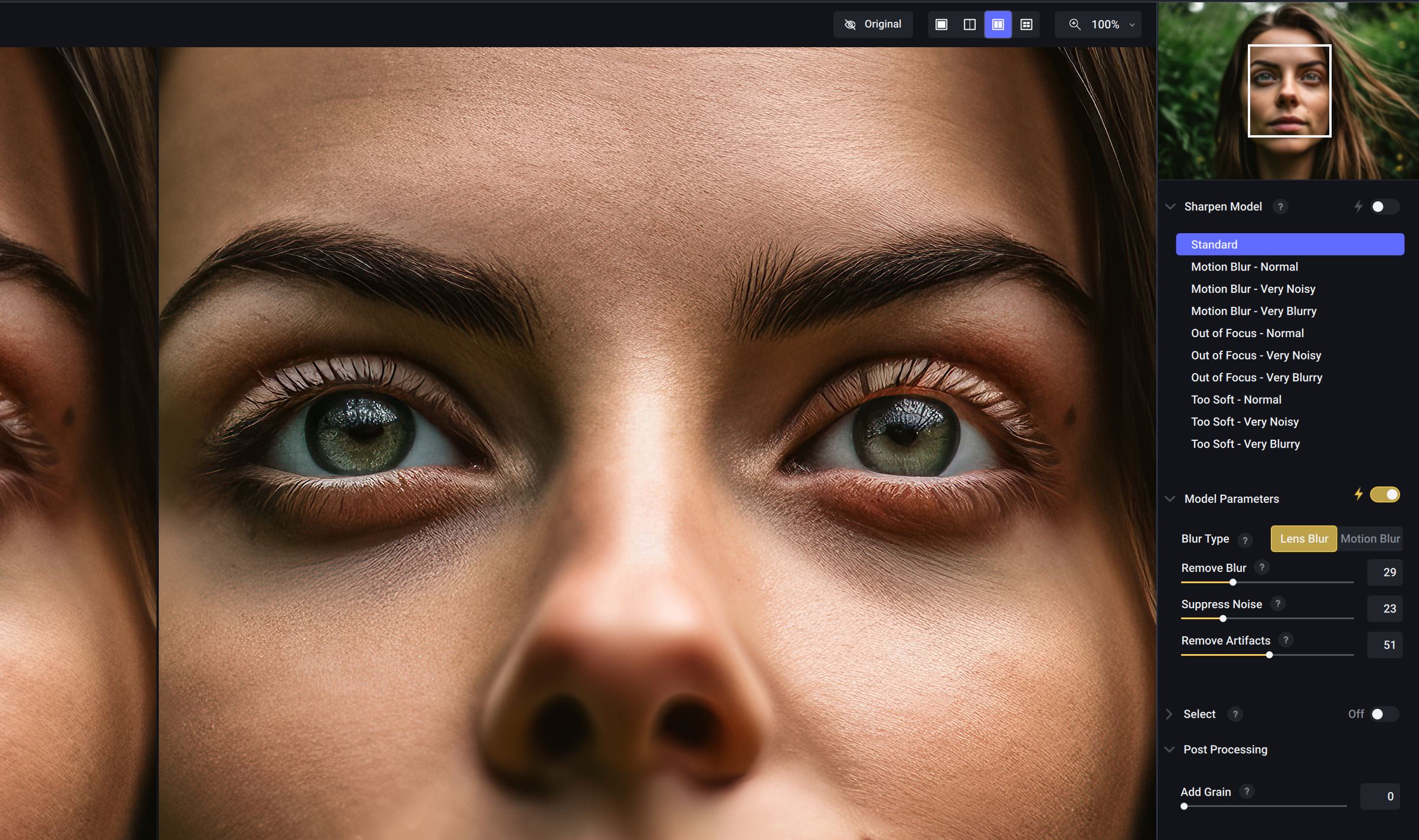
Advanced edge detection: Sharpen AI’s AI-driven edge detection capabilities ensure that only the appropriate areas of an image are sharpened, leaving smooth areas untouched and avoiding unwanted artifacts. There is an automated subject selection which you can refine or use a custom mode to paint the areas you want to Sharpen. This tool is much more precise than Topaz Photo AI’s similar, like a magic wand tool in Photoshop.
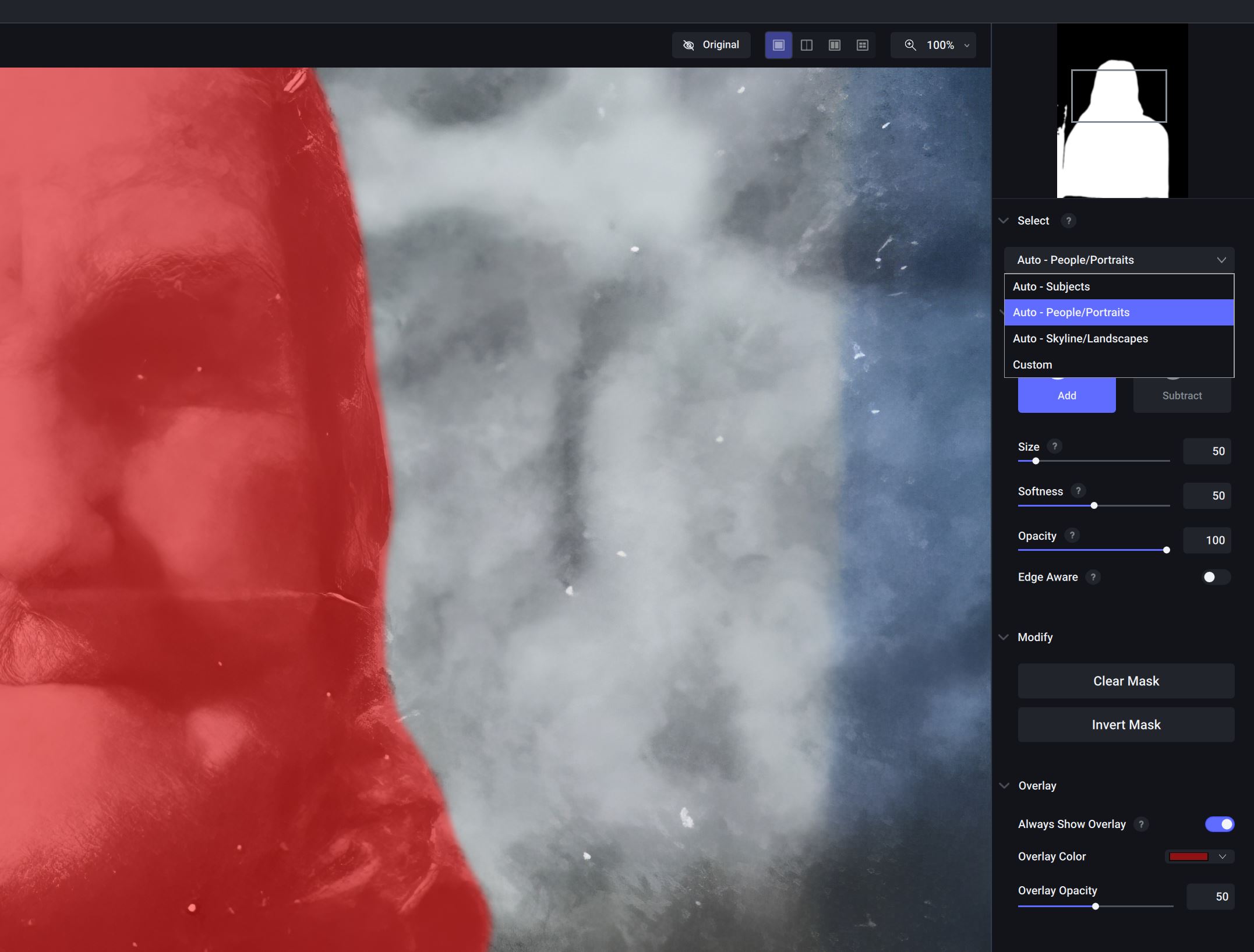
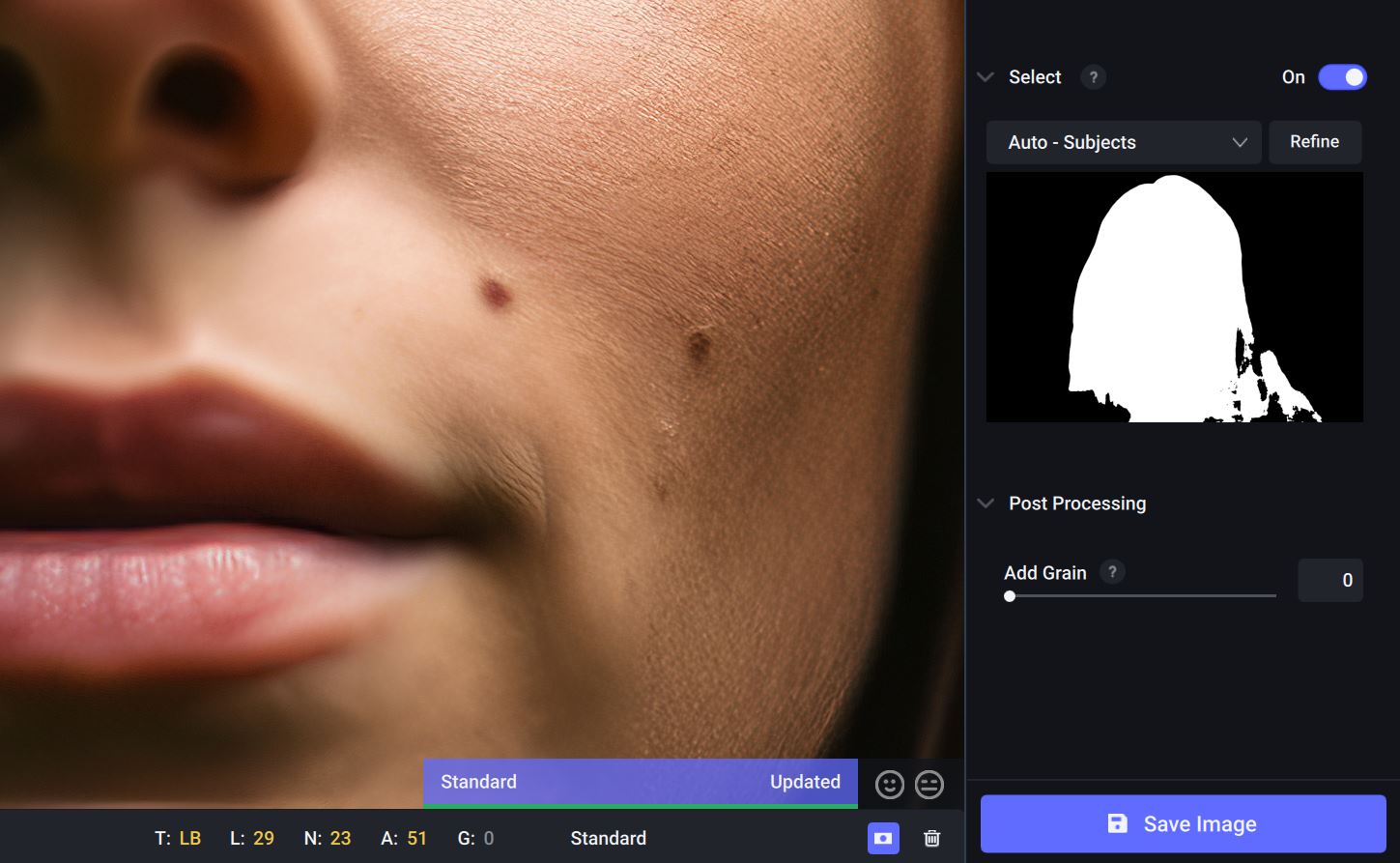
Seamless integration with popular photo editing software: Like other Topaz Labs products, Sharpen AI can be used as a standalone application or as a plugin for industry-standard software like Adobe Photoshop and Lightroom, making it easy to incorporate its powerful sharpening features into your existing workflow.
User-friendly interface: Sharpen AI’s intuitive interface allows users of all skill levels to quickly and easily enhance image sharpness.
Use cases and real-world examples
Sharpen AI is a versatile tool that benefits various photography genres and applications, including:
- Wildlife and sports photography: In fast-moving situations, capturing images that are as sharp as possible can be challenging. Sharpen AI’s Stabilize and Focus modes can rescue slightly blurry shots and enhance overall image sharpness.
- Portrait photography: Perfectly focusing on a subject’s eyes is crucial. If the focus is slightly off, Sharpen AI’s Focus mode can correct soft focus issues and enhance eye sharpness for more captivating portraits.
- Landscape photography: For landscape photographers who want maximum sharpness across their images, Sharpen AI can help fine-tune and enhance image clarity for stunning, high-quality results.
- Low-light photography: When shooting in low-light conditions or at slow shutter speeds, camera shake, and motion blur can be problematic. Sharpen AI’s Stabilize mode can effectively reduce the effects of these issues, restoring image sharpness and salvaging otherwise unusable shots.
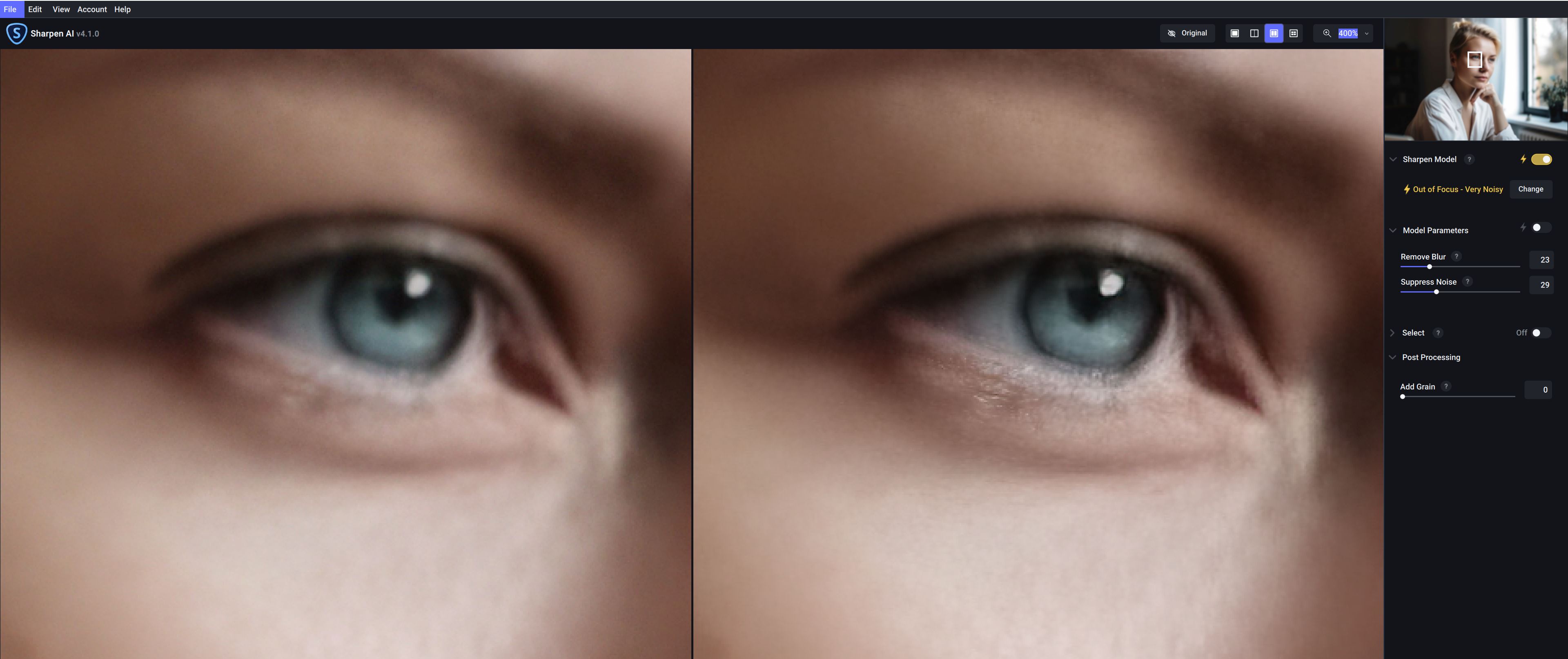
Comparison with other image sharpening solutions
Sharpen AI stands apart from other image-sharpening solutions due to its AI-driven approach and superior results. Here’s how it compares to other popular options:
- Adobe Photoshop: Photoshop offers several sharpening methods, such as Unsharp Mask, Smart Sharpen, and High Pass filter. While these methods can produce acceptable results in some cases, using multiple methods to get good results is pretty time-consuming. They can’t offer the same precise work compared to Sharpen AI’s advanced AI-driven sharpening, which delivers more precise and targeted adjustments without introducing artifacts.
- Capture One: Capture One provides various sharpening tools, including the structure and halo suppression controls. However, its traditional sharpening methods may be less effective than Sharpen AI at correcting motion blur or soft focus issues.
- Luminar Neo: It also incorporates AI-driven sharpening features, but its primary focus is on creative effects and overall image enhancement. Hence, I need to find a sharpening tool that is more effective when just wanting to pinpoint sharp. On the other hand, Sharpen AI is a specialized tool designed to address and correct sharpness issues.
Overall, Sharpen AI’s innovative AI-driven sharpening capabilities make it a top choice for photographers who require precise and effective image sharpening solutions.
V. Topaz DeNoise AI
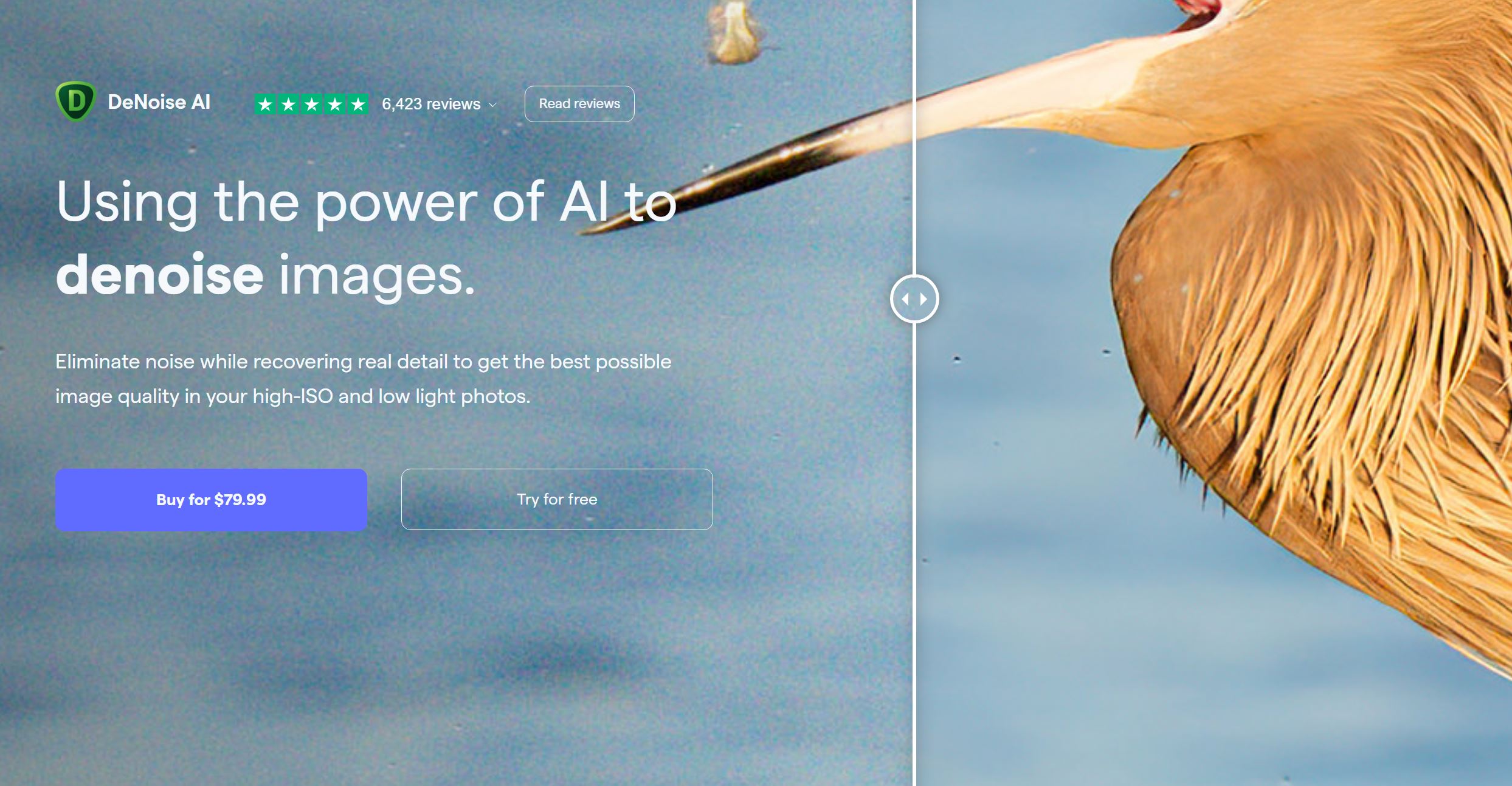
Topaz DeNoise AI is a cutting-edge digital image processing software designed to dramatically reduce image noise while preserving important details. Harnessing the power of advanced AI algorithms, this user-friendly software caters to photographers and creatives of all skill levels, providing unparalleled noise reduction capabilities. DeNoise AI is perfect for various photography styles, including portraits, landscapes, and astrophotography, excelling in low-light conditions and high ISO settings. Enhance your images and elevate your photography with Topaz DeNoise AI.
An in-depth look at Topaz DeNoise AI’s tools
- AI-powered noise reduction: DeNoise AI leverages advanced algorithms and machine learning to differentiate between noise and crucial image details, providing excellent noise reduction while preserving essential details.
- Advanced sharpness control: The software includes sharpness controls, enabling users to fine-tune their images’ sharpness and detail levels, yielding remarkably detailed and precise results.
- Batch processing: DeNoise AI’s batch processing capabilities help photographers enhance their workflow by processing multiple images simultaneously.
Use cases and real-world examples
- Portrait photography: Topaz DeNoise AI shines in portrait photography, effectively eliminating noise while maintaining skin textures, facial features, and other vital details. This results in professional-quality portraits even when shooting in challenging lighting conditions.
- Astrophotography: DeNoise AI is perfect for astrophotographers, as capturing the night sky often requires high ISO settings and long exposures, increasing noise levels. DeNoise AI reduces this noise without losing the intricate details of stars, galaxies, and other celestial objects.
- Landscape photography: Topaz DeNoise AI effectively mitigates noise while preserving essential details in dimly lit environments or situations requiring high ISO settings. This allows photographers to produce clean, high-quality images even in challenging lighting conditions.
- Low-light conditions and high ISO settings: In dimly lit environments or situations that require high ISO settings, Topaz DeNoise AI effectively mitigates noise while preserving essential details. This allows photographers to produce clean, high-quality images even in challenging lighting conditions.
- Wildlife and sports photography: When capturing fast-moving subjects, such as wildlife or athletes, photographers often need to use high ISO settings and fast shutter speeds, which can result in noisy images. DeNoise AI mitigates this issue, preserving crucial details while maintaining image quality.
- Architectural photography: In architectural photography, preserving intricate details and textures is crucial. Topaz DeNoise AI effectively reduces noise without compromising the sharpness and clarity of building features, resulting in crisp and impressive architectural images.
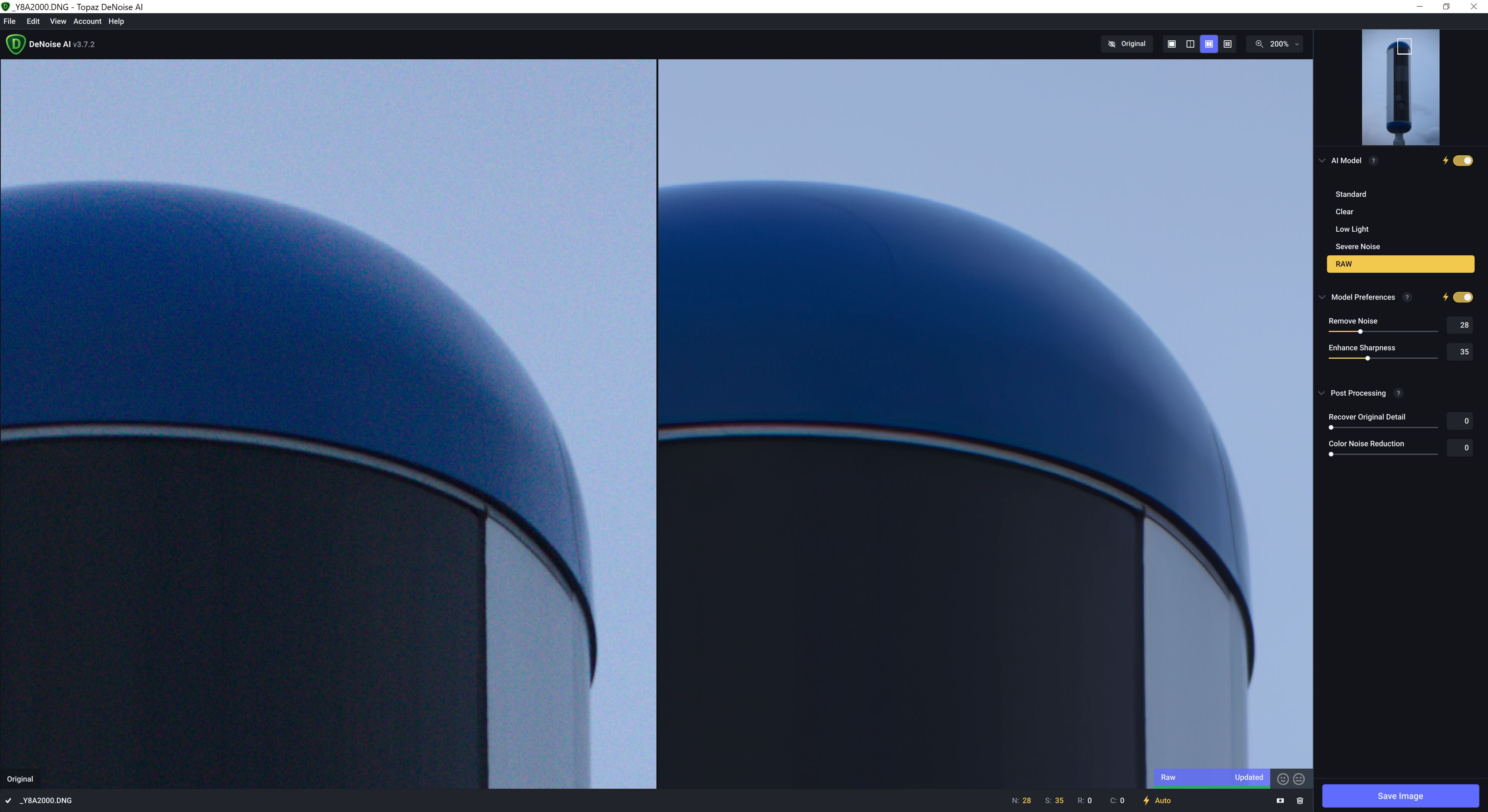
VI. Integrating Topaz Labs’ AI software into your workflow
Compatible with other photo editing software
Topaz Labs’ AI-based photography software, including Topaz Photo AI, Gigapixel AI, and Sharpen AI, is designed to work seamlessly with industry-standard photo editings applications, such as Adobe Photoshop and Lightroom. This ensures you can easily integrate these powerful tools into your workflow without complex workarounds. Additionally, these tools are compatible with Windows and macOS operating systems, catering to a broad range of users.
Standalone applications also offer flexibility for users who prefer to work outside a more extensive editing suite. I end up using standalone versions always when batch editing something and a plugin version when something comes up unexpectedly, like when regular sharpening tools are not enough or I have to crop the original image so much that I have to use AI upscaling to regain the image size back to at least the original.
Batch processing capabilities
Topaz Labs’ AI software provides batch processing capabilities, allowing you to process multiple images simultaneously and save time when working on large projects or series of images. This feature is handy for photographers who require consistent results across a set of images or need to upscale, sharpen, or enhance numerous images quickly.
To use batch processing in Topaz Labs software, select the desired images, choose the appropriate settings, and let the software process the images automatically. This streamlined workflow saves time and ensures consistent quality throughout your project.
General Tips and best practices
To get the most out of Topaz Labs’ AI software, consider these tips and best practices:
- Start with high-quality images: While AI tools can improve image quality, starting with the best source material is essential. High-quality, well-exposed images will yield better results using Topaz Labs software.
- Use the appropriate tool for the job: Topaz Labs offers specialized tools to address specific issues. For example, use Gigapixel AI for upscaling, Sharpen AI for correcting sharpness issues, and Topaz Photo AI for overall image enhancement.
- Don’t over-process your images: While AI-driven tools can deliver impressive results, it’s crucial not to overdo them. Apply adjustments sparingly and constantly review your photos at various zoom levels to ensure the changes appear natural and visually pleasing. It is an excellent technique to check the quality by increasing the zoom level to 100%. That way, you don’t get surprises if you print it out in large format prints.
- Experiment with settings: Each image is unique, so experiment with different settings and modes within the software to find the optimal combination for your specific image. I witnessed those automatic settings are almost always too strong for my taste, and you can experiment with settings to find what suits your tastes and style.
VII. Pricing and Free Trial
Please note that the pricing information provided here is accurate until April 2023. For the latest pricing details, it’s wise to check the Topaz Labs website.
Pricing details for each software
Topaz Photo AI is available for $199.
Gigapixel AI can be purchased for $99.99.
Sharpen AI is available for $79.99.
DeNoise AI is available for $79.99.
Topaz Video AI is not reviewed but is available and costs $299.
Bundle options
Topaz Labs offers the “Best Value Bundle,” which includes DeNoise AI, Gigapixel AI, and Sharpen AI. The bundle is priced at $199,99, offering a special discount compared to purchasing each software separately. This option especially appeals to photographers who can benefit from Topaz Labs’ AI-powered tools.
Free trial availability
For users who want to test the software before purchasing, Topaz Labs offers a 30-day free trial for each of their products. This includes Topaz Photo AI, Gigapixel AI, and Sharpen AI. The free trial provides full access to the software’s features, letting users evaluate the tools and decide if they meet their precise needs and requirements.
Conclusion
Summary of the key features and benefits of each software
- Topaz Photo AI: This powerful photo-enhancing software offers AI-powered image quality enhancements, enabling users to achieve professional results quickly. Key features include upscaling, noise reduction, and detail preservation tools.
- Gigapixel AI: Designed for upscaling images without sacrificing quality. Its features include AI-powered image upscaling, preservation of detail and sharpness, and artifact reduction.
- Sharpen AI: Focused on addressing image sharpness issues. Key features include AI-powered image sharpening, stabilizing mode for shake reduction, and focus mode for fixing soft focus issues.
Topaz Labs’ suite of AI-powered photography software allows professional photographers to enhance their images, rescue bad shots, and achieve high-quality results with improved efficiency. Topaz Photo AI, Gigapixel AI, and Sharpen AI provide innovative tools and features worth exploring. With 30-day free trials, there’s no risk in trying these tools and experiencing the benefits they can bring to your photography.
Final thoughts on AI’s impact on photography
Artificial intelligence is revolutionizing photography, image editing, and enhancement, allowing photographers to push image quality and editing capabilities. Topaz Labs AI-driven tools exemplify this shift, empowering photographers to achieve professional results faster and easier. As AI technology advances, we can expect even more innovative solutions and exciting developments in the world of photography, paving the way for new creative possibilities and transforming how we capture, edit, and share our images.
The rapid development of AI technology in recent years has profoundly impacted the photography industry. I predict that AI innovation will continue to accelerate, leading to a future in which the demand for professional photographers may slow down considerably. As AI-driven tools become increasingly advanced and accessible, the need for human intervention in capturing and editing images could diminish.
Envision a future where AI services can accomplish complex tasks with minimal input. For example, send a few decent-quality cellphone photos of your company’s employees and office space to an AI-powered system. You could then provide the AI with brand guidelines and describe your corporate images’ desired mood and aesthetics. The AI could generate a series of stunning, ready-to-use images featuring your actual staff members in the office and meeting rooms and engaging in various corporate tasks. These images would perfectly align with your brand identity, creating a cohesive and appealing visual narrative.
AI will reduce the need for professional photographers, art directors, graphic designers, and producers in this future scenario. Companies no longer need to invest large sums of money to produce high-quality brand materials. Instead, they could rely on advanced AI services to deliver equally remarkable upshots at a fraction of the cost and time.
While we may not be there yet, the pace of AI development suggests that such a future is around the corner. In as little as three years, AI technology could dramatically transform the photography and creative industry, ushering in a new era of creative possibilities and reshaping the role of photographers and other creative professionals.
Thank you for reading!
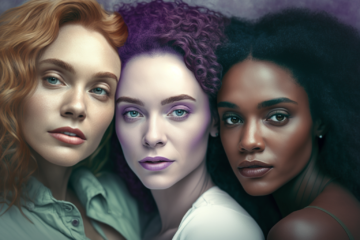


0 Comments